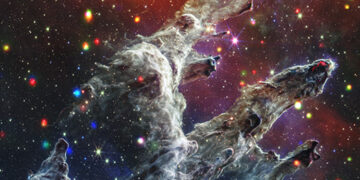Fast Radio Bursts (FRBs) are some of the universe’s most enigmatic and energetic phenomena. Discovered in 2007, these millisecond-long bursts of radio waves have puzzled astronomers for years, with thousands detected since their initial discovery. Their origins, mechanisms, and extreme energy levels—capable of briefly outshining entire galaxies—have been the subject of intense debate.
The Discovery: Pinpointing FRB 20221022A
The journey to understanding FRBs took a significant leap with the discovery of FRB 20221022A, a radio burst originating from a galaxy about 200 million light-years away. By analyzing the scintillation—fluctuations in the FRB’s brightness—astronomers were able to determine its precise location. Remarkably, the burst was traced to the magnetosphere of a neutron star, located just 10,000 kilometers from its surface.
Scintillation occurs when light from a small, bright source filters through dense gas, causing it to twinkle. By studying this effect, the team confirmed that FRB 20221022A originated from an extremely small region, providing the first conclusive evidence that FRBs can emerge from the magnetospheres of neutron stars.
Neutron Stars: Cosmic Powerhouses
Neutron stars are among the universe’s most extreme objects. Formed from the remnants of massive stars after supernova explosions, they are incredibly dense, with masses exceeding that of the Sun packed into a sphere the size of a city. Their magnetospheres are highly charged regions, with magnetic fields strong enough to rip apart atoms.
FRBs like 20221022A appear to be powered by the energy stored in these magnetic fields. As the magnetic field twists and reconfigures, it releases bursts of energy in the form of radio waves. This discovery settles a long-standing debate, confirming that at least some FRBs originate from the turbulent magnetic environments surrounding neutron stars.
How Scintillation Helped Crack the Code
The key to this breakthrough was the use of scintillation as a diagnostic tool. By analyzing the FRB’s brightness variations, scientists were able to zoom in on its source. The technique relies on how light interacts with gas along its path, bending and scattering in ways that create a twinkling effect. This allowed researchers to confirm that the burst originated within the magnetosphere of the neutron star.
The degree of scintillation provided clues about the size and proximity of the FRB’s source. Smaller, closer objects produce more pronounced scintillation, and FRB 20221022A exhibited exactly the patterns expected from a region just 10,000 kilometers wide. This discovery highlights the potential of scintillation as a powerful tool for studying other FRBs.
Why This Discovery Matters
Understanding the origins of FRBs has significant implications for astrophysics. For years, scientists have debated whether these bursts are produced by processes close to their source, such as magnetospheric activity, or by far-reaching shockwaves. The findings from FRB 20221022A settle this debate, at least for some FRBs, confirming that they can arise from the immediate vicinity of neutron stars.
This discovery also opens up new opportunities to study extreme physics. Neutron star magnetospheres are among the most intense environments in the universe, and FRBs offer a unique window into their dynamics.
The Broader Implications
FRBs are not just a curiosity; they are a key to unlocking some of the universe’s greatest mysteries. By studying these bursts, astronomers can learn about the distribution of matter in the cosmos, the behavior of magnetic fields, and the physics of compact objects like neutron stars and black holes. The discovery that FRBs can originate from magnetospheres suggests that similar mechanisms might occur in other extreme environments, potentially involving black holes or exotic states of matter.
This research also highlights the diversity of FRBs. While FRB 20221022A emerged from a neutron star’s magnetosphere, other bursts might have different origins. The ability to pinpoint their locations using techniques like scintillation will be crucial for unraveling the full range of FRB phenomena.
What’s Next in FRB Research?
The discovery of FRB 20221022A is just the beginning. With instruments like the Canadian Hydrogen Intensity Mapping Experiment (CHIME), which detects several FRBs daily, researchers are poised to uncover even more about these mysterious signals. The scintillation technique used in this study could help identify the origins of other FRBs, providing a clearer picture of their diversity and mechanisms.
Key questions remain: Do all FRBs originate from neutron stars? Can other compact objects, like black holes, produce similar bursts? How do the magnetic fields of neutron stars evolve, and what role do they play in shaping FRBs? Future studies will aim to address these questions, using advanced telescopes and international collaborations.
Conclusion: A New Era of Understanding
The discovery of FRB 20221022A’s origins marks a significant milestone in astrophysics. By pinpointing its source within the magnetosphere of a neutron star, scientists have confirmed a long-suspected connection between FRBs and extreme magnetic environments. This breakthrough not only resolves a major debate but also opens up new avenues for exploring the most intense regions of the cosmos.
Reference:
Magnetospheric origin of a fast radio burst constrained using scintillation



















